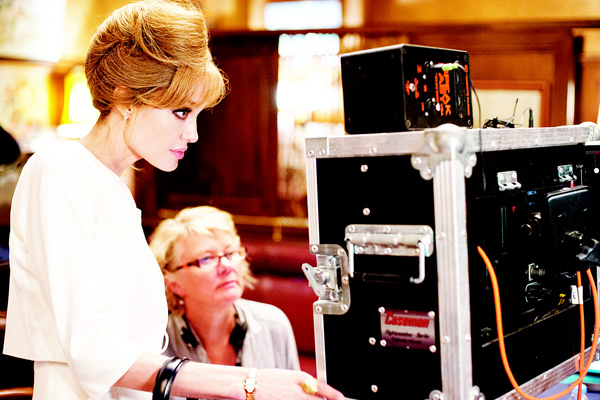08/11/2015
08/11/2015
 In this photo provided by Universal Pictures, Angelina Jolie Pitt (left), directs and stars as Vanessa on the set of the film ‘By the Sea’. The movie releases in US theaters on Nov 13. (AP)
In this photo provided by Universal Pictures, Angelina Jolie Pitt (left), directs and stars as Vanessa on the set of the film ‘By the Sea’. The movie releases in US theaters on Nov 13. (AP)LOS ANGELES, Nov 7, (Agencies): Retreating from wartime horrors (“Unbroken,” “In the Land of Blood and Honey”) to explore the less perilous minefield of a troubled marriage, Angelina Jolie Pitt pulls off a halfway compelling trick with “By the Sea,” . Drenched in so many photogenic shades of cream, tan and khaki that it might as well have been titled “Beige Valentine,” this glossy Euro-modernist-art-film throwback casts the writer-director and her husband, Brad Pitt, as a gorgeously unhappy 1970s American couple seeking to escape their demons during an extended stay on the Maltese coast. Meandering and overlong in ways that will test the patience of even die-hard Brangelina fans, the film ultimately feels too dramatically reductive and obvious to pull off its desired cocktail of Albee and Antonioni, limiting its appeal primarily to those viewers who can get drunk on visual pleasure alone.
Likely to meet with some audience curiosity upon its initial rollout Nov 13, though not enough to sustain a strong commercial showing, this Universal release reps the first starring vehicle for Pitt and Jolie Pitt in the decade since “Mr & Mrs Smith” (2005), the homicidal-marital-therapy comedy that famously set the actors’ off-screen relationship in motion. While they wed only just last year (prompting the director’s change in billing), their fictional alter egos here have already been married 14 years when we first see them speeding through Malta in a top-down convertible. They are Roland (Pitt) and Vanessa (Jolie Pitt), and their every gesture — every frown through tinted shades, every silent inhalation of cigarette smoke — amply confirms that they are the two most impossibly, unapproachably chic people ever to grace this uniquely scenic corner of the Old World.
Taking up residence in a large hotel suite with a balcony overlooking the Mediterranean, the two settle into an uneasily meandering rhythm that matches the film’s own. Roland, a novelist, is trying to get over a bad case of writers’ block, though he’d get more done if he didn’t hole up daily at the local bar, run by a friendly, grizzled proprietor (a fine Niels Arestrup). Vanessa, a former dancer, remains indoors most of the time, occasionally venturing out for a walk to the market or the water’s edge. He’s tired and sardonic; she’s sullen and depressive.
Meassure
The two seem to have agreed, almost as a pre-emptive measure, to spend as little time together as possible. When they’re in the same room, the air between them feels charged with unhappiness, for reasons that they don’t feel especially inclined to clue us in about.
The levels of narrative and visual interest kick up a slight notch with the arrival of Lea (Melanie Laurent, who starred with Pitt in “Inglourious”) and Francois (Melvil Poupaud), a honeymooning French couple who offer our protagonists a bittersweet glimpse of their younger, happier selves. In its best and most amusingly perceptive moments, “By the Sea” surveys the romantic/therapeutic properties of voyeurism, as Roland and Vanessa seem alternately turned on, perplexed, saddened and vaguely threatened by what’s transpiring next door, prompting the first real stirrings of husband-and-wife communication in some time.
Neither this nor the tentative, surface-level interactions that follow are enough to turn them into compellingly drawn figures, leaving the actors with little to do but fall back on their not-inconsiderable star wattage. Jolie Pitt proves a canny enough director of her own husband, who brings his strong physicality to bear on the role of Roland in an effectively restrained way (he also speaks rather good French in his extended conversations with Arestrup). But the actress struggles to spin a coherent performance from what feels like a collection of tortured, grief-stricken poses, and there’s something too studied about the way her outdoor attire (thick sunglasses, long sleeves, broad-brimmed hats) functions as shorthand for her emotional-zomboid state. Jolie Pitt’s most arresting star turns in recent years (particularly in “Changeling” and “Maleficent”) have accentuated her beauty to an almost otherworldly degree, but here, the attention paid to details of her wardrobe and makeup feels distracting and self-conscious, particularly in a few instances of excessively streaky, borderline-ghoulish eyeshadow.
Detachment
Over the course of the film’s leisurely two-hour running time, it’s possible to be moved in fits and starts by stray scenes from this marriage — particularly when Roland tenderly cradles a sobbing Vanessa in the shower — but in an almost entirely abstract, depersonalized way. That detachment becomes even more pronounced in the film’s faltering final stretch; rather than rooting her characters’ marital woes in a sort of inexplicable, free-floating malaise, Jolie Pitt falls into the trap of providing a concrete explanation. By the time the sad, cliche truth finally comes out, it arrives far too late to surprise those viewers who have been paying attention.
Doing work that could hardly be more different from his Oscar-nominated black-and-white lensing on “The White Ribbon,” d.p. Christian Berger captures Malta’s sun-drenched exteriors and the beige-and-ivory interiors of Jon Hutman’s production design using mostly natural light, with often exquisite results.
“By the Sea” is a very personal film for Jolie Pitt — and not just because it reunites her onscreen with her husband, Brad Pitt. It’s not even because she wrote, directed, produced and stars in the film.
“By the Sea” is personal because it was inspired by the grief of losing her mother in 2007, Jolie Pitt said Thursday at the film’s premiere, AFI Fest’s opening-night gala at Hollywood’s TCL Chinese Theatre.
She started writing when she was missing her mother, without knowing exactly what she was creating.
“When you write something from a blank page, it’s very hard to say, ‘This is important,’ because you don’t know: It’s your own life. It’s your own depression. It’s your own questions about your mother. Grief. Where to put your pain,” Jolie Pitt said. “For me, it was important to try to do it. And it was important to try to do it for my mother. It was important for myself.”
“By the Sea” is a slow, quiet drama about a wealthy American couple on a French seaside retreat. Roland (Pitt) is there to write, but mostly just ends up drinking. Vanessa (Jolie Pitt) is there to relax, but ends up grumping around and popping pills. They avoid each other and their relationship is clearly strained. Their dynamic begins to change when they befriend (and secretly spy on) a newlywed couple on their honeymoon.
The Hollywood Reporter’s Todd McCarthy called “By the Sea” “the kind of vanity project you don’t see much of anymore.” He wrote that it was a languid attempt at European arthouse cinema that “will prove once again that even the biggest names in the world won’t draw an audience to something that, in and of itself, has no reason for being.”
“By the Sea” — Jolie Pitt’s third directorial feature — could hardly be more different.
Alonso Duralde of TheWrap.com bemoaned the movie’s “dreary scenes from a dull marriage,” adding that it was hard “watching these two talented actors play blanks who have no chemistry with each other.”
Critics praised the cinematography as exquisite but said the stunning visuals failed to make up for a weak script and a plot where nothing much happens.
Scott Mendelson at Forbes.com admired the film more than he enjoyed it and said it may appeal to fans of talky, beautiful to look at foreign movies. “For anyone else, it will probably come off like a feature-length perfume commercial punctuated by outbursts of emotion and light kink.”
Fred Topel of the NerdReport.com, was kinder than most of the early reviewers on Friday. “Any time you get to see a filmmaker’s soul on display, if that doesn’t intrigue you enough for two hours, you’re missing out,” he wrote.


